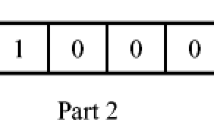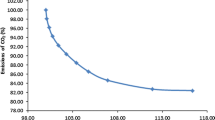Abstract
Rail transportation system is a green mode that saves energy and reduces the negative impacts. Integrating road and rail systems, known as intermodal transportation, contributes to a sustainable business environment. In this article, based on a sequential game, an integrated multi-level intermodal network design problem (IMINDP) is addressed. On the upper level, a government as the Stackelberg leader with environmental, economic, and social concerns decides whether or not to establish intermodal terminals and rail corridors, considering budget limitation and minimization of both internal and external costs. On the lower level, freight shippers as the Stackelberg followers decide how to transport their freight shipments through rail, road, and intermodal networks, considering rail accessibility, capacity constraints and internal costs minimization. A mathematical programming model is developed to formulate the shippers’ best response to the decisions adopted by the government. Due to NP-hard nature of the problem, a three-level solution approach, based on the Genetic Algorithm (GA) and novel heuristic indicators, is proposed. An exhaustive enumeration algorithm is presented to achieve the optimal solutions as benchmarks for evaluating the solutions obtained by the proposed solution approach. An experimental analysis based on a real-world case indicates the great efficiency of the proposed solution approach. According to the results, a decrease in available budget of infrastructure construction leads to an increase in total external and internal costs imposed on the government. It is also inferred that external transportation costs internalization, as an effective pricing policy, plays a significant role in the strategic network design decisions.










Similar content being viewed by others
Data Availability
The datasets generated during and/or analyzed during the current study are not publicly available, but are available from the corresponding author on reasonable request.
Notes
On the middle level, the freight logit discrete choice models are employed (see Appendix C). According to Lüer-Villagra and Marianov (2013), logit discrete choice models are currently the most popular ones regarding discrete choice in the network design problems, since the logit models consider several different attributes including cost, travel time, amount of demand, and so on. In the current paper, the attributes of the logit models are divided into two categories: some attributes are associated with the transportation modes, including the internal cost, travel time, and accessibility. Some other ones are associated with the type of commodities, including value, density, flammability, and perishability.
References
Alibeyg A, Contreras I, Fernández E (2016) Hub network design problems with profits. Transp Res Part E Logist Transp Rev 96:40–59. https://doi.org/10.1016/j.tre.2016.09.008
Alumur S, Kara BY (2008) Network hub location problems: The state of the art. Eur J Oper Res 190(1):1–21
Alumur SA, Kara BY, Karasan OE (2009) The design of single allocation incomplete hub networks. Transp Res Part B Methodol 43(10):936–951
Aminzadegan S, Mohammad T, Majid F (2021) An integrated production and transportation scheduling problem with order acceptance and resource allocation decisions. Appl Soft Comput 112:107770
Arnold P, Peeters D, Thomas I, Marchand H (2001) Pour une localisation optimale des centres de transbordement intermodaux entre réseaux de transport: formulation et extensions. Canadian Geographer/le Géographe Canadien 45(3):427–436
Atta S, Sen GJC, Engineering I (2021) A new variant of the p-hub location problem with a ring backbone network for content placement in VoD services. Comput Ind Eng 159:107432
Bektaş T, Ehmke JF, Psaraftis HN, Puchinger J (2019) The role of operational research in green freight transportation. Eur J Oper Res 274(3):807–823. https://doi.org/10.1016/j.ejor.2018.06.001
Congress UJPL (1991) Intermodal surface transportation efficiency act. 102–240
Contreras I, Cordeau J-F, Laporte G (2011) The dynamic uncapacitated hub location problem. Transp Sci 45(1):18–32
Contreras I, Fernández E, Marín A (2009) Tight bounds from a path based formulation for the tree of hub location problem. Comput Oper Res 36(12):3117–3127. https://doi.org/10.1016/j.cor.2008.12.009
Contreras I, Fernández E, Marín A (2010) The Tree of Hubs Location Problem. Eur J Oper Res 202(2):390–400. https://doi.org/10.1016/j.ejor.2009.05.044
Dai W, Zhang J, Sun X, Wandelt S (2019) HUBBI: Iterative network design for incomplete hub location problems. Comput Oper Res 104:394–414
de Camargo RS, Miranda G (2012) Single allocation hub location problem under congestion: Network owner and user perspectives. Expert Syst Appl 39(3):3385–3391
de Miranda Pinto JT, Mistage O, Bilotta P, Helmers E (2018) Road-rail intermodal freight transport as a strategy for climate change mitigation. 25:100–110
Demir E, Huang Y, Scholts S, Van Woensel T (2015) A selected review on the negative externalities of the freight transportation: Modeling and pricing. Transp Res Part E Logist Transp Rev 77:95–114
Falsafain H, Mohammad T (2019) A novel dynamic programming approach to the train marshalling problem. IEEE Trans Intell Transp Syst 21(2):701–710
Ghane-Ezabadi M, Vergara HA (2016) Decomposition approach for integrated intermodal logistics network design. Transp Res Part E Logist Transp Rev 89:53–69. https://doi.org/10.1016/j.tre.2016.02.009
Goli A et al (2020) Multiobjective fuzzy mathematical model for a financially constrained closed‐loop supply chain with labor employment. Comput Intell 36(1):4–34
Ishfaq R, Sox CR (2010) Intermodal logistics: The interplay of financial, operational and service issues. Transp Res Part E Logist Transp Rev 46(6):926–949. https://doi.org/10.1016/j.tre.2010.02.003
Lin B, Liu C, Wang H, Lin R (2017) Modeling the railway network design problem: A novel approach to considering carbon emissions reduction. Transp Res Part D Transp Environ 56:95–109. https://doi.org/10.1016/j.trd.2017.07.008
Lin C-C, Chiang Y-I, Lin S-W (2014) Efficient model and heuristic for the intermodal terminal location problem. Comput Oper Res 51:41–51. https://doi.org/10.1016/j.cor.2014.05.004
Lin C-C, Lee S-C (2010) The competition game on hub network design. Transp Res Part B Methodol 44(4):618–629. https://doi.org/10.1016/j.trb.2009.09.002
Lin C-C, Lee S-C (2018) Hub network design problem with profit optimization for time-definite LTL freight transportation. Transp Res Part E Logist Transp Rev 114:104–120. https://doi.org/10.1016/j.tre.2018.03.007
Lüer-Villagra A, Marianov V (2013) A competitive hub location and pricing problem. Eur J Oper Res 231(3):734–744. https://doi.org/10.1016/j.ejor.2013.06.006
Meng Q, Wang X (2011) Intermodal hub-and-spoke network design: incorporating multiple stakeholders and multi-type containers. Transp Res Part B Methodol 45(4):724–742
Mokhtar H, Redi AP, Krishnamoorthy M, Ernst AT (2019) An intermodal hub location problem for container distribution in Indonesia. Comput Oper Res 104:415–432
Mostert M, Caris A, Limbourg S (2018) Intermodal network design: a three-mode bi-objective model applied to the case of Belgium. Flexible Serv Manuf J 30(3):397–420. https://doi.org/10.1007/s10696-016-9275-1
O’Kelly ME, Campbell JF, de Camargo RS, de Miranda Jr G (2015) Multiple allocation hub location model with fixed arc costs. Geogr Anal 47(1):73–96
O’Kelly ME, Luna HPL, De Camargo RS, De Miranda GJN, Economics S (2015) Hub location problems with price sensitive demands. Netw Spat Econ 15(4):917–945
Öztürk C, Tuzkaya G, Bulkan SJC, Engineering I (2021) Centrality based solution approaches for median-type incomplete hub location problems. Comput Ind Eng 156:107275
Ruan J, Wang X, Chan F, Shi Y (2016) Optimizing the intermodal transportation of emergency medical supplies using balanced fuzzy clustering. Int J Prod Res 54(14):4368–4386
Santos BF, Limbourg S, Carreira JS (2015) The impact of transport policies on railroad intermodal freight competitiveness–The case of Belgium. Transp Res Part D Transp Environ 34:230–244
Sarhadi H, David MT, Manish V (2022) A tri-level mixed-integer program for the optimal fortification of a rail intermodal terminal network. Int J Oper Res 43(1–2):65–95
Seyedvakili SA, Azadani SMN, Zakeri JA, Shafahi Y, Karimi M (2018) New model for the railway network design problem. J Transport Eng Part A Syst 144(11). https://doi.org/10.1061/JTEPBS.0000180
Shafiepour M, Mohammad T, Mahdi A (2018) A methodology to prioritize the construction projects of new railway infrastructures for privatization in railway networks (Case Study: Iran). Int J Transport Eng 6(2):123–143
Sörensen K, Vanovermeire C, Busschaert S (2012) Efficient metaheuristics to solve the intermodal terminal location problem. Comput Oper Res 39(9):2079–2090. https://doi.org/10.1016/j.cor.2011.10.005
Tamannaei M et al (2016a) A novel train rescheduling approach in double-track railways: optimization model and solution method based on simulated annealing algorithm. Int J Civ Eng 14(3):139–150
Tamannaei M et al (2016b) A double-track train rescheduling for incident conditions: optimisation model and decomposition method. Int J Oper Res 26(1):62–87
Tamannaei M, Hamid Z, Sajede A (2021a) A game-theoretic approach to the freight transportation pricing problem in the presence of intermodal service providers in a competitive market. Netw Spat Econ 21(1):123–173
Tamannaei M, Hamid Z, Morteza RB (2021b) A game theoretic approach to sustainable freight transportation: Competition between road and intermodal road–rail systems with government intervention. Transport Res Part B Meth 153:272–295
Tavassoli K, Mohammad T (2020) Hub network design for integrated Bike-and-Ride services: a competitive approach to reducing automobile dependence. J Clean Prod 248:119247
Teye C, Bell MG, Bliemer MC (2018) Locating urban and regional container terminals in a competitive environment: An entropy maximising approach. Transport Res Part B Methodol 117:971–985. https://doi.org/10.1016/j.trb.2017.08.017
Teye C, Bell MGH, Bliemer MCJ (2017a) Entropy maximising facility location model for port city intermodal terminals. Transp Res Part E Logist Transp Rev 100:1–16. https://doi.org/10.1016/j.tre.2017.01.006
Teye C, Bell MGH, Bliemer MCJ (2017b) Urban intermodal terminals: The entropy maximising facility location problem. Transp Res Part B Methodol 100:64–81. https://doi.org/10.1016/j.trb.2017.01.014
van Essen H, van Wijngaarden L, Schroten A, Sutter D, Bieler C, Maffii S, Parolin R (2019) Handbook on the external costs of transport, Version 2019
Wang R, Yang K, Yang L, Gao Z (2018) Modeling and optimization of a road–rail intermodal transport system under uncertain information. Eng Appl Artif Intell 72:423–436. https://doi.org/10.1016/j.engappai.2018.04.022
Yang K, Yang L, Gao Z (2016) Planning and optimization of intermodal hub-and-spoke network under mixed uncertainty. Transp Res Part E Logist Transp Rev 95:248–266
Zhang M, Janic M, Tavasszy LA (2015) A freight transport optimization model for integrated network, service, and policy design. Transp Res Part E Logist Transp Rev 77:61–76. https://doi.org/10.1016/j.tre.2015.02.013
Zhang Q, Wang W, Peng Y, Zhang J, Guo Z (2018) A game-theoretical model of port competition on intermodal network and pricing strategy. Transp Res Part E Logist Transp Rev 114:19–39. https://doi.org/10.1016/j.tre.2018.01.008
Author information
Authors and Affiliations
Corresponding author
Ethics declarations
Competing Interests
The authors declare that they have no known competing interests or personal relationships that could have appeared to influence the work reported in this paper.
Additional information
Publisher's Note
Springer Nature remains neutral with regard to jurisdictional claims in published maps and institutional affiliations.
Highlights
• A sustainable approach to an integrated multi-level intermodal network design problem is presented.
• The optimal design of intermodal terminals and rail corridors are investigated subject to different viewpoints of decision makers.
• A novel solution approach based on GA and heuristic indicators are proposed.
• Internalization of external transportation costs plays a significant role on strategic network design decisions.
Supplementary Information
Below is the link to the electronic supplementary material.
Rights and permissions
Springer Nature or its licensor holds exclusive rights to this article under a publishing agreement with the author(s) or other rightsholder(s); author self-archiving of the accepted manuscript version of this article is solely governed by the terms of such publishing agreement and applicable law.
About this article
Cite this article
Taheri, S., Tamannaei, M. Integrated Multi-Level Intermodal Network Design Problem: A Sustainable Approach, Based on Competition of Rail and Road Transportation Systems. Netw Spat Econ 23, 1–37 (2023). https://doi.org/10.1007/s11067-022-09577-6
Accepted:
Published:
Issue Date:
DOI: https://doi.org/10.1007/s11067-022-09577-6




